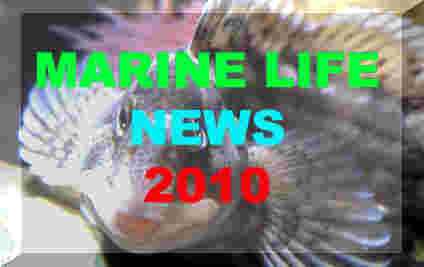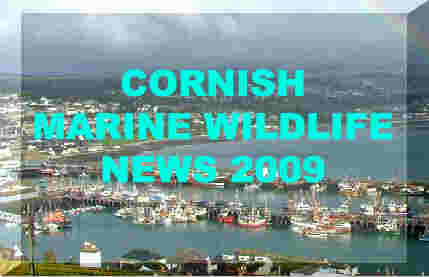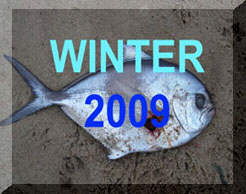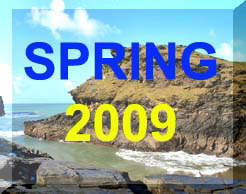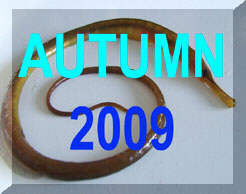EVENTS:
 27-29
March 2009
27-29
March 2009
Porcupine
Marine Natural History Society Annual Meeting
Topic:
Seashore
to Sea Floor
Venue:
University
of Plymouth, Davy Building Main Hall on Friday and Saturday
Coxside
Marine Centre in Plymouth on the Sunday, with access to microscopes
and running seawater.
LATEST
NEWS:
9 December
2009
The
very first positive record of a Greater
Amberjack, Seriola
dumerili, for the seas around the island
of Guernsey was caught
by commercial fisherman Steve Fallaize off
Rousse,
off the north-west coast of the Channel Island. It weighed 585 grams.

Greater
Amberjack
Photograph
by Richard
Lord (Guernsey)
Sealord
Photography
Only
twelve of this fish have ever been recorded caught around the British Isles
dating from the first one caught off Salcombe in Devon in 1951. It
can be mistaken for the rarely caught Guinean
Amberjack,
Seriola
carpenteri. (This species was only
described in 1971.) The differences between the Greater
Amberjack and the Guinean
Amberjack are minor. They differ in gill raker
count and ratio of second dorsal fin lobe height to fork length ratio.
Full
Report
BMLSS
Amberjacks
12
November 2009
The
Marine and Coastal Access Bill received Royal Assent
The
Act will create a new marine planning system designed to bring together
the conservation, social and economic needs of our seas. A network of Marine
Conservation Zones will be created that will protect rare and threatened
species and habitats. Four regional projects have started working with
local groups and businesses to identify which areas will be designated
as Marine Conservation Zones.
DEFRA
Press Release
DEFRA:
Legislation Page
DEFRA:
Key Areas
2 November
2009

Sperm
Whale washed ashore at Balmedie
Photograph
by James Ross
on flickr
30
October 2009
A
40 tonne, 13 metre long Sperm Whale, Physeter
macrocephalus,
was found dead on Balmedie
Beach in Aberdeenshire, north-east Scotland.
Stranding
in the Moray Firth 2008
Whales
& Dolphins in British Seas
BMLSS
Cetaceans
22
October 2009

About
5:00
pm on the shore of Barry
Island beach, Vale of Glamorgan, South Wales, a chap spotted a fin
sticking out of the water and hauled in a dead Broad-billed
Swordfish,
Xiphias
gladius,
watched by a swarm of congregating gulls. The
last British report was also washed up on Barry Island in July
2008.
BMLSS
Swordfish
27
September 2009
On
a dive out of John
o' Groats (the most northerly settlement of mainland Scotland) I discovered
the rarely reported free swimming tunicate Thetys vagina
as well as the Mauve Stinger Jellyfish, Pelagia
noctiluca, both seen in shallow (10 metres deep) water, within
two or three metres of the surface. Thetys was observed swimming
by opening and closing its mouth and propelling itself along under the
cliffs at Skirza
Head (eastern coast).

Thetys
vagina has been rarely recorded in Irish
waters. The species was reported for the first time in Irish waters during
November
1988 when hundreds of specimens were taken
in trawls at offshore. A few specimens were also found stranded on Ventry
Beach, near Dingle,
County Kerry during July 1987 & 1988.
BMLSS
Tunicata
BMLSS
Jellyfish
10-12
September 2009
A
9.5 metre long Humpback Whale, Megaptera
novaengliae, was discovered washed
up dead at Erith, Greater
London, in the River
Thames. On 10 September 2009 a
large whale was spotted at Tilbury
at least ten miles to the east (where the river narrows to 732 metres wide)
and this is believed to be the same one. The young male Humpback
Whale is believed to have starved to death.
This
is the first record of a Humpback
Whale recorded in the Thames, although
a large whale of this species was
washed up dead on the north Kent coast at Deal
in 2006. The
Humpback
Whale is a deep water species but these whales
occasionally wander into the southern North Sea where they can become disorientated
and starve to death. In 2006
another
young whale became lost and died in the Humber. In 2006
it was a Northern
Bottle-nosed Whale that was washed up dead
up at Lambeth in London.
BBC
News Report
BDMLR
Report
Whales
and Dolphins in British Seas (by Steve Savage)
BMLSS
Cetacea
Whale
Watching (Britain)
12
August 2009
Thousands
of fish have died of suffocation in the seas of St.
Austell Bay in south Cornwall.
"The
more we looked, the more dead fish we found, mainly small ones, but eventually
even about half a dozen Cuckoo Wrasse,
Labrus
bimaculatus, - a beautiful red and
blue fish, and some others which someone identified as baby Dogfish,
Scyliorhinus
canicula,
all unmarked but dead in
rock pools or on the shoreline. One chap even hauled out a large Conger
Eel, Conger conger, from a pool,
obviously dead."
The
dead fish coincided with a large bloom
of plankton that had been blown into the bay. The bloom had turned
the water brown and left sludge deposit on the shore. The exact species
has not yet been identified.
Western
Morning News Report
Wild
About Britain Forum (Report)
Web
Site Report by David
Fenwick
Selected
microphytoplankton species from the North Sea
16
June 2009
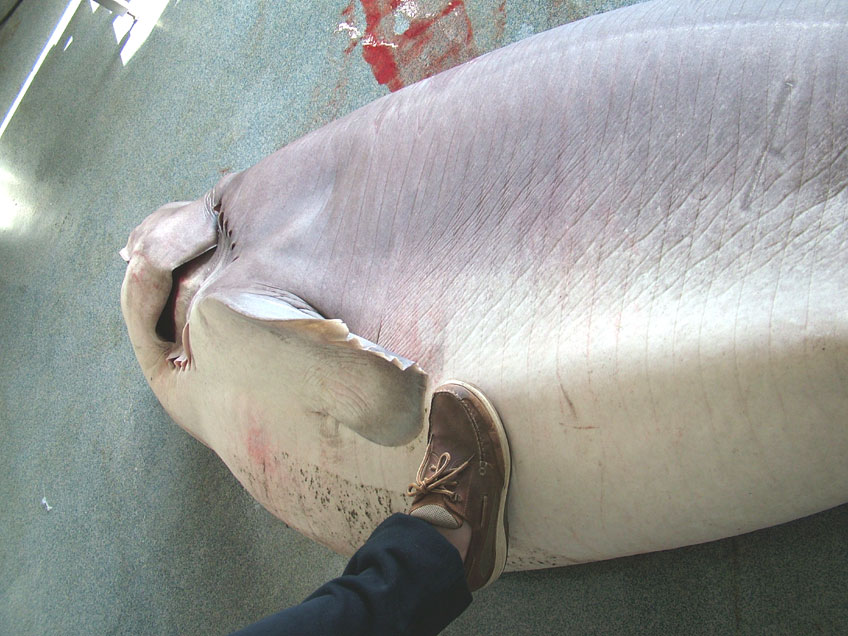
A rod
caught Blunt-nosed Six-gilled Shark,
Hexanchus
griseus, was landed on board the Clare
Dragoon out of Carrigaholt,
County
Clare, south-west Ireland. The fish which weighed in at 480 kg, (1056
lb),
beats the existing European angling record which stands at 466 kg and was
landed in the Azores.
BMLSS
Six-gill Sharks Page 1
BMLSS
Six-gill Sharks Page 2
BMLSS
Sharks & Rays
12
June 2009
A
most unusual capture of a 120 cm long (Mediterranean)
Moray Eel, Muraena
helena, weighing about 11 kg, was
caught by West Penwith fishermen
on their "Trevessa"
beam trawler just 60 miles off Newlyn
Harbour, Cornwall. This is the first one this
century and only ten are on record of this temperate-tropical fish being
caught in UK seas, the previous ones being caught in the 1990s. They are
a North East Atlantic fish being found from Senegal to the English Channel
(and also in the Mediterranean).
Mail
Online Report & Photograph
Previous
Report 2004 from Ireland
Earlier
March 1999 Report from Newlyn Fish Market
Earlier
Report from Herm, Channel Islands 1996
>16
May 2009
Billions
of krill-like pelagic
Hyperiid
Amphipods (small
crustaceans)
were
washed up on the strandline at Redcar
and Saltburn in north-east
England (North Yorkshire). The local people reported that the strandings
of amphipods have occurred for several weeks prior to this report.

A previous
mass stranding of amphipods occurred on the North Sea coast in 1966.
Thousands
more were discovered washed up at Whitby
in North Yorkshire.
More
Images
12
May 2009
A
large native European Oyster,
Ostrea
edulis, weighing 1.36 kg, width
180 mm, length 170 mm and depth 70 mm was spotted on Plymouth fish
market in a box of mixed fish bought by merchant,
Peter
Randall of Mevagissey, and is now in the Mevagissey
Aquarium.
2007
Previous
Report of a large Oyster
BMLSS
Oyster & Slipper Limpet
BMLSS
Molluscs
30
April 2009
A
Saupe,
Sarpa
salpa, was caught by the Looe trawler
Guiding Light II, skipper Andy Giles about
six miles south of the Eddystone reef (i.e. about 16 miles south of Plymouth).
The specimen was 370 mm long, the body plump but elongated with ten longitudinal
yellow stripes. This Sea
Bream (Sparidae)
has only been recorded once before in British seas at St. Peter Port, Guernsey,
Channel Islands (on Zostera
beds at a spring tide) in 1983.
List
of NE Atlantic Sparidae
1 March
2009
An
unusual octopus was captured in a shallow water net off Brittany, France,
by Nick
Praed on the "Silver
Dawn" fishing out of Newlyn, Cornwall.
Expert
opinion identified the octopus as the deep water species Haliphron
atlanticus. It was probably
the smaller male as the females can grow very
large.
They
are interesting animals which appear to only have only seven arms as the
eight one is very small. Records of its occurrence in the eastern Atlantic
are exiguous, with specimens caught off Ireland and off the Shetland Isles,
Scotland.
Full
Report
BMLSS
Octopuses
24
February 2009
Another
Oarfish
(or Ribbon Fish),
Regalecus
glesne, was discovered near
some cliffs at Tynemouth Pier, north-east England. This time the three
metre long fish was in a good condition.
Previous
Report
1 February
2009
An
unusual discovery washed up on the shore at Hauxley near Amble
in Northumberland on the north-east coast of England was the decaying remains
of an Oarfish (or Ribbon Fish),
Regalecus
glesne. This is a deep water species
and the longest fish found in the oceans reaching a length of 11 metres.
The
last known record was from Skinningrove,
Cleveland on the north-east coast in 2003.
BMLSS
Oarfish
29
January 2009
Commercial
fisherman Steve Fallaize
caught a Two-banded Sea Bream,
Diplodus
vulgaris, in a gill net set over night
one mile off L'Ancresse off the north coast of Guernsey. It weighed 1011
grams.
Sealord
Photography
This
fish is a new record for the British Isles. It is principally a Mediterranean
species and is also found on the Atlantic Seaboard of continental Europe
and North Africa including Brittany where it is rare.
January
2009
Ray's
Bream,
Brama
brama, continue their strandings on the east coast of England and
Scotland.
More
Reports
British
Marine Life News 2008

Cornish
Marine Life Records 2008
BMLSS
Oil Disasters page


